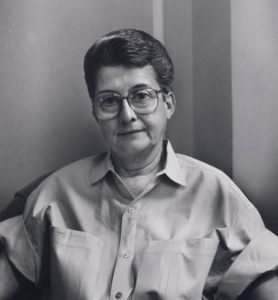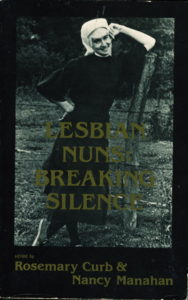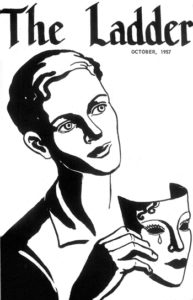Looking Back 35 Years: Barbara Grier, Catholic Lesbians, and the Lesbian Nuns Book
In 1985 the book, Lesbian Nuns: Breaking Silence, was published by Naiad Press. It was an explosive best-seller, thanks to the Boston Archdiocese and Cardinal Bernard Law, who complained about a local television interview with the book’s two editors. The archdiocese described the program as “an affront to the sensitivity of Roman Catholics.” The station cancelled the segment, and sales soared. “This is crazy,” Barbara Grier, a founder of Naiad Press told The New York Times, scrambling to fill orders for the book, “I’m a mouse giving birth to an elephant.” The editors, Rosemary Curb and Nancy Manahan, did have a successful appearance on the Phil Donohue show in April 1985 and went on a national tour for the book. Naiad Press went through four printings of the book, and eventually sold the mass distribution and paperback rights to Warner Books in 1986. Lesbian Nuns eventually sold several hundred thousand copies. 
Lesbian Nuns: Breaking Silence included stories by 42 former nuns and women religious, and nine women still in religious life. Most used pseudonyms. All of them wrote about either discovering or acting on their lesbian identity while still in religious life. While there were very few detailed descriptions of sex and seduction, Naiad’s marketing promised to reveal what really goes on behind convent doors, breaking the silence “about erotic love between women in religious life.” While the lesbian religious in the book had affairs or relationships with other sisters, they also fell in love or lust with lay women, married and single. Often the love affair or sexual relationship was the cause of them leaving the convent: it was too hard to maintain a lover relationship and live a religious life. Sometimes the relationships continued but often they did not. I met and knew several of the contributors:
Nancy Manahan, one of the co-editors, worked with the Conference for Catholic Lesbians (CCL) to solicit contributors to the book. She also did a workshop on the book at our 1986 conference. I found Nancy to be a lovely, gracious, caring person.
Susan Weaver was an elegant, elderly woman. We got together several times during my visits to my parents home in Vermont. She made me a beautiful Christmas ornament that I put on my tree every year in memory of her.
Pat O’Donnell was a Dominican sister working at Picture Rocks Retreat house in Tucson, Arizona. She lost her job as the result of her coming out in the book. Pat continued to live and work in Tucson doing spiritual direction.
“Kate Quigley” lived in Montreal and had a long-term relationship with a married woman. The woman’s husband was aware of it. The three of them would go away on vacation together.
Charlotte Doclar worked with Sr. Jeannine Gramick at New Ways Ministry to outreach to lesbian nuns. I met her at a retreat for Catholic lesbians in 1981. Charlotte was friendly, jocular and good-natured. Her story is on the LGBTQ Religious Archives Network.
Dianne Weyers entered her community when she was 14. She left when she was in her late 30s or early 40s with a mysterious back ailment no doctor was able to diagnose but had a crippling effect on her. Since she could not sit upright for long, I typed her manuscript for the book. She felt very unwanted and persecuted by her community, particularly one sadistic superior. I never quite knew what to make of her.
“Sister Maria Nuscera” was a very vivacious lesbian religious in the Midwest. She fell in love and had an affair with a parishioner.
Margaret “Peg” Cruikshank was not one of the lesbian nuns but was one of the driving forces behind the creation of the book. Rosemary Curb and Nancy Manahan, the book’s co-editors, had previously published their own stories as lesbian religious in The Lesbian Path. Peg edited that book and introduced the pair in June 1981. She suggested to Barbara Grier that Manahan and Curb edit a book about lesbian nuns.
The nun on the cover of the book with the “come hither” look was Jean O’Leary, who left the convent and went on to become a co-director of the National Gay and Lesbian Task Force. 
The Conference for Catholic Lesbians (CCL), was a group founded in the early 1980s to promote Catholic lesbian visibility and community. Beginning in 1982, the group had advertised and promoted the Lesbian Nuns book project to its members and readers, many of whom were lesbian religious and ex-nuns. CCL’s newsletter editor at that time, a wonderful woman named Pat, knew of Barbara Grier through the Daughters of Bilitis. DOB or Daughters was the first lesbian rights organization in the United States. Pat had been one of the editors of its newsletter, The Ladder. She described Grier as an aggressive, single-minded butch.
The unthinkable happened shortly after the publication of Lesbian Nuns. Barbara Grier, working to maximize income and visibility, offered excerpts of the book to gay and women’s publications like Philadelphia Gay News and Ms. Magazine. She also offered excerpts to Forum magazine; a men’s soft-core porn magazine published by Penthouse. The lead headline in the June 1985 Forum blared in capital letters: SEX LIVES OF LESBIAN NUNS. The lesbian nun stories that Forum bought included “They Shall Not Touch, Even in Jest,” “Finding My Way” and “South American Lawyer in the Cloister.”
Grier justified the decision by stating it would help the book reach a wider audience. She claimed that many women, some of them closeted lesbians, read their male family members’ copies of the magazine. An estimated 15% of Forum readers were female. In an interview with WomaNews, she expressed surprise about the outrage her Forum sale generated— “I had no idea anyone would object.” Even if you are a huge Barbara Grier fan, these two assumptions are hard to accept.
Since CCL had helped to solicit contributors to the book, personally, and through our conferences and newsletter, the organization sent a letter to Barbara Grier protesting the sale of the stories to Forum. We did get a letter back from her a few weeks later. The letter is now lost, but I remember what she wrote. The tone was matter of fact, no apology. She sold the rights to Forum to try to reach as many lesbians as possible. I don’t know if the tiny sliver of lesbian Forum readers would even be interested in the book, but the ensuing controversy certainly helped sales and attracted new customers to Naiad Press. Lesbian Nuns was their greatest publicity tool and best-selling book ever.
Naiad Press was founded in 1973 by Barbara Grier, her partner, Donna McBride, and another couple, Anyda Marchant and Muriel Crawford. The business began with $2,000 provided by Marchant, their first author. She wrote under the pen name, Sarah Aldridge. Over the years Naiad published over 500 books on unconditionally lesbian themes. Mostly romance novels, they included erotica, mysteries and science fiction. Naiad also reprinted some of the most important lesbian pulp novels of the 1940s and ‘50s, including the Beebo Brinker Chronicles by Ann Bannon. Their authors included Jane Rule, Katherine V. Forrest, Claire McNab, Lee Lynch and Karin Kallmaker. Cartoonist Alison Bechdel used to lampoon Naiad books by giving them bar code covers. Grier told Bechdel when she met her that she always loved seeing Naiad jokes in her comic strip. The founders fiercely disagreed over the Forum sale and it precipitated a split a few years later. 
In 1973, no bookstores would take lesbian themed books, so Naiad started as a mail order business. Its initial list of 3800 names was the Daughters of Bilitis (DOB), membership list that Grier purloined when the organization folded in 1970. Grier used it to keep publishing The Ladder, DOB’s newsletter, for another two years until funding ran out. Many DOB activists felt Grier stole the list, but she defended her action as necessary for the magazine’s continued existence: “DOB was falling apart—we wanted The Ladder to survive.”
Grier got her start at DOB in 1957 as a book reviewer. Her reviews were written under the pseudonym Gene Damon. She wanted to “nourish all lesbians with books.” In 1968 she became editor of The Ladder. The magazine increased from 25 to more than 40 pages and tripled in subscriptions. She removed the word “Lesbian” from the front cover in order to reach more women. Her makeover was successful but not without conflict. She increased coverage of feminist news, but some DOB members wanted the focus to remain exclusively lesbian. In the late 1960s, the Daughters of Bilitis finally broke under the stresses and conflicts surrounding the political vs. the social aspects of the group; and whether to align with male-dominated gay rights groups, or lesbian separatist feminists. Grier was in the latter camp. The founders of DOB, Phyllis Lyon and Del Martin, leaned more toward acceptance and assimilation. 
I skimmed my copy Lesbian Nuns a few months ago, and it spurred me to reflect on what I thought about Barbara Grier now, 35 years after I helped draft CCL’s protest letter to her. I also revisited my 2011 post on Grier, written shortly after she died.
In 1985, I thought Grier was a crud. How could a lesbian publisher sell personal, and often sad and painful coming out stories to a men’s sex magazine? Her goal–to reach as many lesbians as possible- was enough to override every other consideration and objection.
In 2020, my view of Grier is more nuanced. In order to become a successful publisher of lesbian literature in a homophobic world, she needed to be single-minded, relentless and ambitious to endure and prevail. She was a hard worker, tough, and totally dedicated to her ideal of lesbian visibility. “Her goal in publishing,” said Donna McBride, “was to make lesbians happy about themselves.” Books that made lesbians feel secure in their sexual identities were the best. Grier succeeded, and made the world a better place for lesbians. They could see themselves and their lives in books at last. 
Grier was also blunt, nasty, calculating, and operated with flexible ethics—think of the Forum sale and the DOB membership list theft. I wonder if she had the idea of starting a book company when she took the list. I bet she did.
As lesbians and gay men continue to integrate into ordinary life and communities, workplaces, parishes, television shows and elected offices, this quote from Grier in 1968 flashes a warning: “When we have amalgamated and homogenized and pasteurized ourselves thoroughly, we can become one of the shapeless, formless, meaningless, ‘walk alike, talk alike, think alike’ things that now live in this country—and then who will write our poetry, our novels of intensity, who will burn a futile fire, howl at the moon aimlessly?”

April 3rd, 2020 at 4:55 am
Fascinating post & well crafted. Thanks also for links.
Stay you safe.
April 3rd, 2020 at 6:26 am
Polo, we are fine so far. Truthfully, I’m not sure what to believe since people are panicking, and the news media is goosing the crisis to keep viewers tuned in. I have stopped watching TV, and feel less anxious being outdoors or reading quietly with God beside me. Infection seems widespread, but deaths are low so far in the US…low in comparison to annual flu fatalities and our drunken drivers. (That adds up to about 65,000 a year.) What happens in the next two weeks is key. I am now starting to be more concerned about malnutrition and disease with so many people out of work. Please take good care and stay safe. All the best.
April 3rd, 2020 at 5:10 pm
Forgot to say I tweeted this post.
https://twitter.com/irlpol/status/1246006916322660361
April 4th, 2020 at 7:25 am
Thank you! Researching and writing the post filled me with admiration for the lesbians and gay men who struggled in the 1940s, 50s and 60s under horrible conditions to connect and affirm each other as persons worthy of respect and dignity. I don’t think we can honor them enough for their bravery and sacrifices.